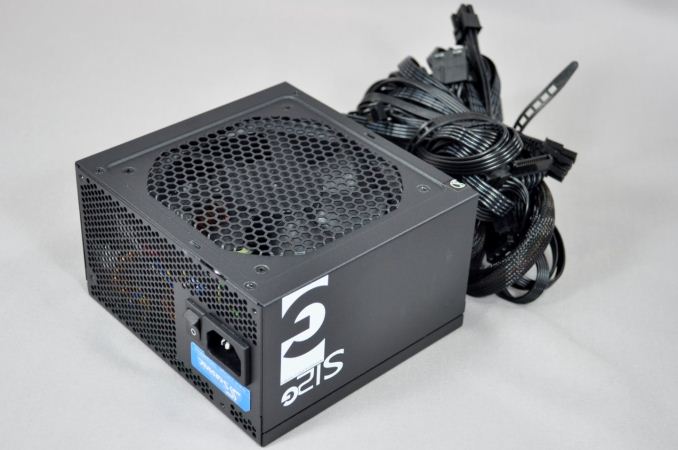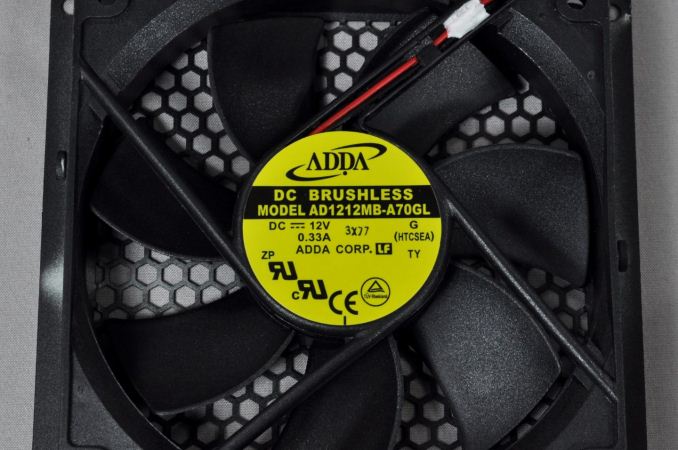Seasonic S12G 650W Power Supply Review
by E. Fylladitakis on February 28, 2014 2:20 PM EST- Posted in
- Cases/Cooling/PSUs
- Seasonic
- 80 Plus Gold
External Appearance
The Seasonic S12G sports a small, typical ATX-sized (140mm) chassis that has been sprayed with a matte black paint. Some effort has been made to improve the appearance of the power supply, albeit not all of the measures can be considered successful. Seasonic uses all-black ribbon cables, with the exception of the 24-pin ATX cable that uses typical color-coded wires and sleeving. A blue sticker has been placed on the rear of the unit, where it will be visible from the back of a case once the PSU has been installed. Oddly enough however, the company sprayed the series logo in white on the right side of the chassis, where it will be facing the right side panel of a case. It goes without saying that it will not be visible inside the vast majority of the cases currently in the market. On the other hand, the sticker with the specifications of the PSU has been placed on the left side of the chassis. No effort has been made at all to enhance the top side of the chassis visually, so in a bottom-mounted location users with case windows will simply see a black surface.
Internal Design
We were surprised the instant that we opened up the chassis of the S12G 650W unit. The unit is cooled by an ADDA AD1212MB-A70GL fan, unlike the majority of Seasonic's other models that use SanAce fans. The particular fan model is high quality, featuring a "Hypro" liquid bearing and with a maximum speed of 2050 RPM, yet it is no SanAce. When you have to compete in the mainstream market and even a few dollars can make an immense difference on sales, you have to keep the retail price as low as possible, which is most probably why Seasonic went with the ADDA fan for the S12G. Note also that as this unit has no fanless mode, it does not require a fan with extraordinary specifications (e.g. a very low starting voltage).
It is obvious that the OEM behind the S12G is Seasonic, as the company designs, manufactures, and markets their own units. We spot four heatsinks; the smallest one handles the rectifier bridge, the one near the edge of the PCB cools the active PFC components, and those on each side of the main transformer handle the inversion and conversion transistors of the primary and secondary stage respectively. The input filter begins on the PCB attached to the back of the receptacle, but continues on the main PCB until the input of the rectifier bridge. We spot a total of six Y capacitors, two X capacitors, and two filtering inductors, which form an excellent intake filter.
In terms of component and build quality, Seasonic does not let us down. The primary capacitor and most of the smaller capacitors are supplied by Nippon Chemi-Con, with some Rubycon electrolytic capacitors after the secondary side heatsink as well. Everything is well shielded and secured with glue, ensuring the mechanical cohesion of the unit. The inductors are glued and also tightened with cable ties, in order to minimize the chance of vibration-generated noise (also known as "coil whine"). The quality of the soldering is very good, well above what we would consider average. There are a few spots where excessive solder has been applied, but that hardly is worth commenting on in a $90 MSRP PSU.






















77 Comments
View All Comments
tynopik - Saturday, March 1, 2014 - link
> if I short the rectifier bridgeI mean on the component side. Cables can and do short and it should NOT cause permanent harm to the PSU (or to other components on other cables). If it does, the PSU is poorly designed.
> if the distibution grid around your area shifts like "a DJ is rotating the knob", which is not really possible (infinite bus theory)
The request is based off an incident that actually did happen to me. The power dipped 3 times in quick succession and the power supply blew and took out everything connected to it. Granted this was before I knew better and it was a crappy unit running right at its limit, but PSUs do have to deal with power 'variances' in the real world.
E.Fyll - Sunday, March 2, 2014 - link
Shorting a component = OCP protection. I always perform such tests before proceeding to testing the unit. I don't it that to fail catastrophically with $12.000 connected to it...I do understand that this might have had happened to you. It most likely was due to the catastrophic failure of a distribution grid's component. Still, that is not a fault of the PSU, it is an issue with your energy supplier. Your energy supplier is under contract to provide you with electricity of specific quality. If you have such severe problems with your distribution grid, you do not need a better PSU, you need a lawsuit.
HangFire - Monday, March 3, 2014 - link
I'm glad to hear you test OCP. Will you be testing it on all 3 voltage rails?As for voltage variances, they are not typically due to catastrophic failures. Quite mundane failures such as tree and animal shorts happen often, and there is a high voltage protocol to burn them off and resume normal power that sounds just like the poster's experience.
Power in proximity to manufacturing areas can show the effects of large electric motor startup and shutdown. Grids switching in and out contingent power sources can introduce phase issues, and so on.
Blowing all of these off as unusual or the result of large failure is not realistic.
HangFire - Monday, March 3, 2014 - link
Here is a good overview: http://apcdistributors.com/white-papers/Power/WP-1...E.Fyll - Tuesday, March 4, 2014 - link
It is entirely realistic, simply because a) they are unusual and b) are not a problem of the PSU itself but a problem caused by your grid.Large motors and appliances that could cause a voltage drop are not being fed by the consumer distribution grid. Anything above a medium industry is being powered by polyphase distribution. So you being in the same grid as a massive motor, no, it is not going to happen. You are connected on a distribution bus, which is nearly infinite (hence the term "infinite bus") and will no bulge even when huge generators start. If there is an appliance capable of causing a voltage surge or drop connected into the residential grid near you, that is a problem.
Trees and animals are a) not mundane failures and b) definitely not just being "burned off and resume". If an animal shorts two distribution phases and no safety kicks in, the current inbalance will easily destroy a large transformer in milliseconds.
The faults that are being described in APC's white paper certainly are correct and possible. Well, to an extend; after all, it is a paper meant to advertise how good having a UPS is, not really a scientific document. This does not mean that they are frequent, nor that they can be replicated by "rotating the knob". See these ups and downs the waveform does in their examples? Your household grid is doing 50 or 60 of them, depending on where you live, *per second*. The faults rarely have a length of more than a few milliseconds. Rotating a knob 100.000 times per second is definitely not possible, specialized equipment is required to replicate any such test.
HangFire - Friday, March 7, 2014 - link
I'm not the one suggesting the knob methodology.I would have agreed with you when I lived in the suburbs. Since moving to a rural area, I can assure you that brownouts, tree related outages and crossed power lines are quite common here. Besides trees the big threat here is drivers hitting utility poles. Very common this time of year, the combination of ice and hill country is quite hazardous, and many of the poles here carry two sets of voltages. In one event just a few years ago, every lightbulb in my house lit up very bright. I lost 5 lightbulbs and 2 small appliances.
HangFire - Friday, March 7, 2014 - link
I guess MY point is that Active PFC power supplies are supposed to take a range of voltages; but I don't see anyone testing that. I test it every few months, when I get out the 100 foot extension cord and use a PC with 5.1 speaker system for party tunes. (My guests are not picky I guess). I use quality hardware, usually a Seasonic so I'm OK but I wonder what the limits are for the cheaper stuff.tynopik - Saturday, March 1, 2014 - link
I can see where 'component side' could be confusing. I mean 'external to the power supply'. No of course I don't expect you to go digging inside a unit and shorting things out.tynopik - Saturday, March 1, 2014 - link
> the performance of a PSU in situations that will almost never arise should not influence a buying decision.it depends on what you mean by 'almost never' and what the consequences of failure in those cases are.
New Orleans is 'almost never' hit by a hurricane. Does that mean they shouldn't worry it?
Saving a few dollars a year by being more efficient in the usual case is great, but if it blows your system during a random power blip, was it worth it?
CeceliaAFolger - Sunday, March 2, 2014 - link
this is a goor site to earn $145 per Month ..........